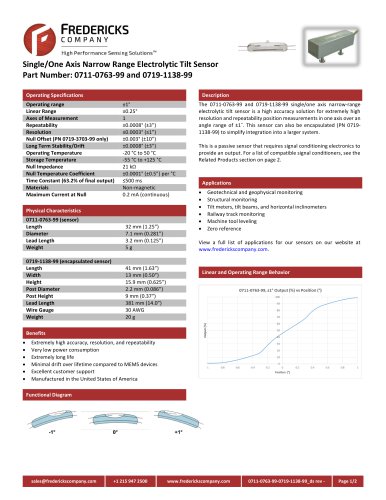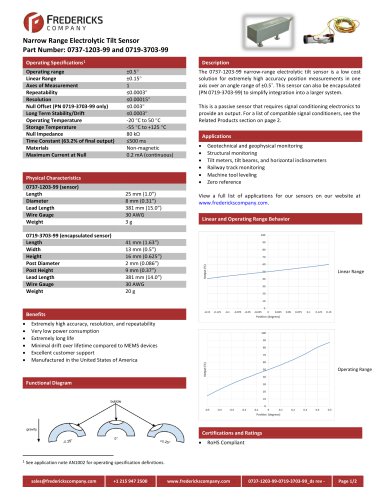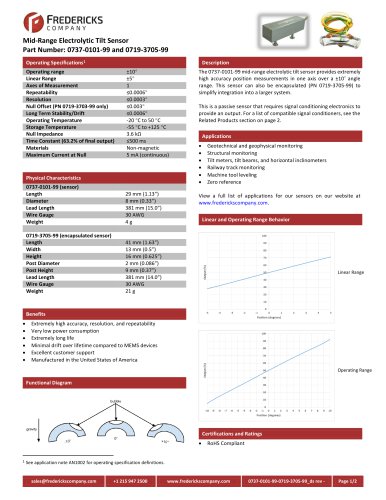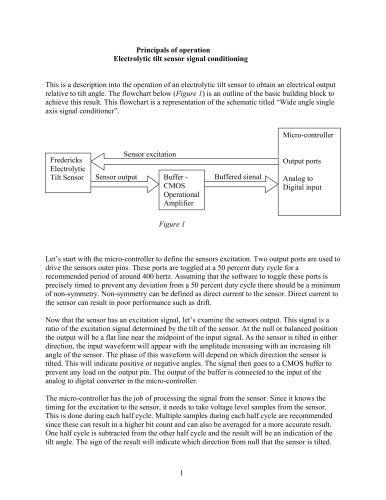
Catalog excerpts
Absolute inclinometers prove advantageous in solar tracking systems The use of an inclinometer is the only way to guarantee long-term accuracy of your solar tracking system because this gravity sensing device will reliably output an absolute angular reading. Read the following three common misconceptions to learn more about the advantages of using an inclinometer in your solar tracker. Misconception #1: Our systems use calculations based on the sun’s location and this formula is built into our tracker module so there is no need for an inclinometer. Response: The algorithm (software program) is actually needed as a part of a closed loop measuring system. But without an absolute measuring device such as an inclinometer (tilt sensing device) you really don’t know if the solar collector (be it module or panel) is truly pointing in the right direction. The algorithm tells the system where to point and the inclinometer confirms that the system is indeed pointing in the correct direction. One can think of the algorithm as a map and the inclinometer as feet on the ground giving feedback. There are conditions that can affect whether or not the solar collector is pointing properly and an open loop system is not able to detect this condition. The items that affect an open loop system can be corrected in a closed loop system as follows: Seismic movement of the solar collector/foundation: A good utility scale solar generator should be designed for at least a twenty year life, however over this life, things can happen. If the system simply drives the collector some number of steps or counts, the position is simply inferred and not known. On the other hand, an inclinometer positioned on the collector gives the system an absolute position. Wind buffeting: Utility scale solar collectors are large devices in which prevailing winds can induce mechanical and angular offsets and if there is not an absolute sensor (aka inclinometer) indicating the true angle then these offsets can affect the angular position. Again, an open loop system with no feedback cannot compensate for the prevailing wind condition.
Open the catalog to page 1Lost transmission data: Sometimes data transmission can get corrupted or lost. Having an inclinometer onboard serves (as mentioned above), as a checking standard for knowing if you are pointing where you want to be pointing. Lost power: This condition is very similar to lost transmission data. If there is no checking standard, such as an inclinometer to give feedback, then under a lost power scenario the system must be recalibrated, thus causing lost operational time. This might be done by going back to stow position and setting off reset switches, etc. The use of an inclinometer gives the...
Open the catalog to page 2All The Fredericks Company catalogs and technical brochures
-
Televac br5003
6 Pages
-
Televac MP7FR Cold Cathode
2 Pages
-
Televac MX4A Convection
2 Pages
Archived catalogs
-
0711-0768-99-0719-1143-99_ds
2 Pages
-
Single Axis Narrow Angle
1 Pages
-
2 A Thermocouple Sensor
2 Pages
-
Glass Mid-Range 0715-4101-99
1 Pages
-
Glass Mid-Range 0714-5701-99
1 Pages
-
Glass Mid-Range 0737-0101-99
1 Pages
-
0703-0703-99 TrueTilt
2 Pages
-
Electrolytictilt
4 Pages













































































